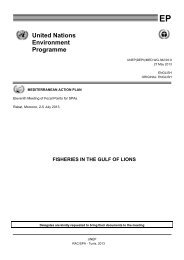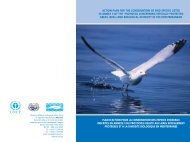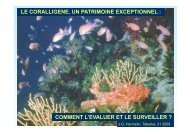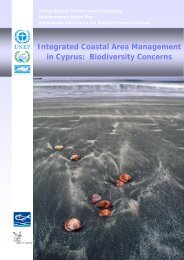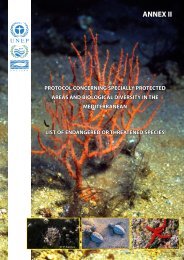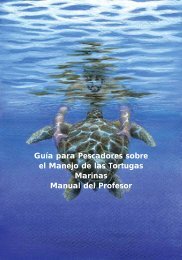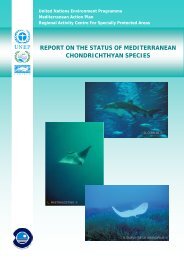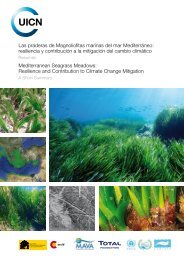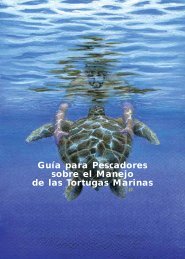Proceedings of the Second Mediterranean Symposium on Marine
Proceedings of the Second Mediterranean Symposium on Marine
Proceedings of the Second Mediterranean Symposium on Marine
Create successful ePaper yourself
Turn your PDF publications into a flip-book with our unique Google optimized e-Paper software.
PROCEEDINGS OF THE SECOND MEDITERRANEAN SYMPOSIUM ON MARINE VEGETATION (ATHENS, 12-13 DECEMBER 2003)<br />
154<br />
CYSTOSEIRA SPP. ASSOCIATIONS IN THE NORTH-EASTERN<br />
MEDITERRANEAN: THE CASE OF EVOIKOS GULF<br />
(CENTRAL AEGEAN SEA, GREECE)<br />
Ioanna VARKITZI 1 , Panayotis PANAYOTIDIS 1 and Barbara MONTESANTO 2<br />
1 Hellenic Centre for <strong>Marine</strong> Research, Institute <str<strong>on</strong>g>of</str<strong>on</strong>g> Oceanography, POB 712, Anavissos 19013, Greece<br />
2 A<str<strong>on</strong>g>the</str<strong>on</strong>g>ns University, Secti<strong>on</strong> <str<strong>on</strong>g>of</str<strong>on</strong>g> Ecology & Tax<strong>on</strong>omy, Panepistiomiopolis 15784, A<str<strong>on</strong>g>the</str<strong>on</strong>g>ns, Greece<br />
Ioanna Varkitzi: e-mail address: ioanna@ath.hcmr.gr<br />
ABSTRACT<br />
The species compositi<strong>on</strong> <str<strong>on</strong>g>of</str<strong>on</strong>g> <str<strong>on</strong>g>the</str<strong>on</strong>g> Cystoseira associati<strong>on</strong>s was studied <strong>on</strong> a gradient <str<strong>on</strong>g>of</str<strong>on</strong>g><br />
decreasing wave energy (from <str<strong>on</strong>g>the</str<strong>on</strong>g> exposed sou<str<strong>on</strong>g>the</str<strong>on</strong>g>rn part <str<strong>on</strong>g>of</str<strong>on</strong>g> <str<strong>on</strong>g>the</str<strong>on</strong>g> gulf to <str<strong>on</strong>g>the</str<strong>on</strong>g> sheltered<br />
nor<str<strong>on</strong>g>the</str<strong>on</strong>g>rn part). Samplings were carried out at four sites <str<strong>on</strong>g>of</str<strong>on</strong>g> <str<strong>on</strong>g>the</str<strong>on</strong>g> Greek NATURA 2000<br />
network. Phytosociological analysis and statistical treatment grouped toge<str<strong>on</strong>g>the</str<strong>on</strong>g>r <str<strong>on</strong>g>the</str<strong>on</strong>g> two<br />
sites at <str<strong>on</strong>g>the</str<strong>on</strong>g> exposed and transiti<strong>on</strong>al part <str<strong>on</strong>g>of</str<strong>on</strong>g> <str<strong>on</strong>g>the</str<strong>on</strong>g> gulf. In <str<strong>on</strong>g>the</str<strong>on</strong>g>se sites <str<strong>on</strong>g>the</str<strong>on</strong>g> dominant species<br />
was Cystoseira crinitophylla and this associati<strong>on</strong> corresp<strong>on</strong>ded to Cystoseiretum crinitae<br />
Molinier 1958. The two sheltered sites formed two distinct groups. The dominant species<br />
was Cystoseira foeniculacea f. tenuiramosa but <str<strong>on</strong>g>the</str<strong>on</strong>g> accompanying species were<br />
different. Despite <str<strong>on</strong>g>the</str<strong>on</strong>g> absence <str<strong>on</strong>g>of</str<strong>on</strong>g> C. sauvageauana, <str<strong>on</strong>g>the</str<strong>on</strong>g> accompanying species make<br />
<str<strong>on</strong>g>the</str<strong>on</strong>g>se two aspects similar to Cystoseiretum sauvageauanae Giacc<strong>on</strong>e 1994. However,<br />
<str<strong>on</strong>g>the</str<strong>on</strong>g>y do not corresp<strong>on</strong>d clearly to any <str<strong>on</strong>g>of</str<strong>on</strong>g> <str<strong>on</strong>g>the</str<strong>on</strong>g> Cystoseira associati<strong>on</strong>s described so far.<br />
Therefore, <str<strong>on</strong>g>the</str<strong>on</strong>g>y could indicate a new type <str<strong>on</strong>g>of</str<strong>on</strong>g> Cystoseiretum sauvageauanae or even a<br />
new associati<strong>on</strong>.<br />
KEYWORDS: Cystoseira, NATURA 2000, <str<strong>on</strong>g>Mediterranean</str<strong>on</strong>g>, Aegean<br />
INTRODUCTION<br />
The genus Cystoseira C. Agardh (Fucales, Phaeophyceae) is part <str<strong>on</strong>g>of</str<strong>on</strong>g> <str<strong>on</strong>g>the</str<strong>on</strong>g> biological identity<br />
<str<strong>on</strong>g>of</str<strong>on</strong>g> <str<strong>on</strong>g>the</str<strong>on</strong>g> <str<strong>on</strong>g>Mediterranean</str<strong>on</strong>g> Sea (Roberts, 1978). Cystoseira species are <str<strong>on</strong>g>the</str<strong>on</strong>g> dominant element<br />
<str<strong>on</strong>g>of</str<strong>on</strong>g> <str<strong>on</strong>g>the</str<strong>on</strong>g> photophilic algal associati<strong>on</strong>s <strong>on</strong> undisturbed hard substrates <str<strong>on</strong>g>of</str<strong>on</strong>g> <str<strong>on</strong>g>the</str<strong>on</strong>g> upper<br />
infralittoral z<strong>on</strong>e (Margalef, 1985). Many studies have dealt with <str<strong>on</strong>g>the</str<strong>on</strong>g> photophilic Cystoseira<br />
associati<strong>on</strong>s <str<strong>on</strong>g>of</str<strong>on</strong>g> <str<strong>on</strong>g>the</str<strong>on</strong>g> W Meditarranean so far (Feldmann, 1937; Molinier, 1960; Giacc<strong>on</strong>e,<br />
1968; Boudouresque, 1969; Verlaque, 1988; Ballesteros, 1990b; Giacc<strong>on</strong>e and Bruni,<br />
1973; Cormaci et al., 1992; Rodriguez and Polo, 1996). In <str<strong>on</strong>g>the</str<strong>on</strong>g> Eastern <str<strong>on</strong>g>Mediterranean</str<strong>on</strong>g>,<br />
Huvé (1972) first studied <str<strong>on</strong>g>the</str<strong>on</strong>g> distributi<strong>on</strong> and ecology <str<strong>on</strong>g>of</str<strong>on</strong>g> <str<strong>on</strong>g>the</str<strong>on</strong>g> Cystoseira species in <str<strong>on</strong>g>the</str<strong>on</strong>g><br />
Aegean Sea. Following researches added more informati<strong>on</strong> about <str<strong>on</strong>g>the</str<strong>on</strong>g> phytosociology,<br />
phytogeography and ecology <str<strong>on</strong>g>of</str<strong>on</strong>g> <str<strong>on</strong>g>the</str<strong>on</strong>g> Cystoseira species in <str<strong>on</strong>g>the</str<strong>on</strong>g> Greek coastal areas<br />
(Harit<strong>on</strong>idis, 1978; Athanassiadis, 1987; M<strong>on</strong>tesanto and Panayotidis, 2000).<br />
Pérès and Picard, (1964) suggested that <str<strong>on</strong>g>the</str<strong>on</strong>g> algal associati<strong>on</strong>s <str<strong>on</strong>g>of</str<strong>on</strong>g> <str<strong>on</strong>g>the</str<strong>on</strong>g> genus Cystoseira<br />
should be c<strong>on</strong>sidered as <str<strong>on</strong>g>the</str<strong>on</strong>g> final stage (climax stage) in <str<strong>on</strong>g>the</str<strong>on</strong>g> ecological successi<strong>on</strong> <str<strong>on</strong>g>of</str<strong>on</strong>g> <str<strong>on</strong>g>the</str<strong>on</strong>g><br />
photophilic algal associati<strong>on</strong>s in <str<strong>on</strong>g>the</str<strong>on</strong>g> <str<strong>on</strong>g>Mediterranean</str<strong>on</strong>g>. Striking differences have been found by




